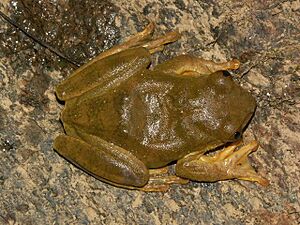Red tree frog facts for kids
Quick facts for kids Red tree frog |
|
|---|---|
 |
|
| Conservation status | |
| Scientific classification | |
| Synonyms | |
|
Hylambates rufus (Reichenow, 1874) |
The red tree frog (Leptopelis rufus) is a cool kind of frog that lives in trees! It's part of the Arthroleptidae family. You can find these frogs in parts of Africa, like southeastern Nigeria, western Cameroon, Equatorial Guinea, western Gabon, and parts of the Republic of the Congo, Democratic Republic of the Congo, and northwestern Angola. Sometimes, people get them mixed up with other similar frogs, especially the palm forest tree frog.
Contents
What Does the Red Tree Frog Look Like?
Adult male red tree frogs are about 4.5 to 5.5 centimeters (about 2 inches) long. Females are bigger, measuring about 7.4 to 8.7 centimeters (about 3 inches) from their snout to their bottom.
Their backs are brown with darker, wavy stripes across them. Their lower legs also have 3 or 4 stripes. Their feet are fully webbed, which helps them climb and move around. They have shiny golden eyes! A special way to tell them apart from other frogs is their small eardrum, called a tympanum. This small eardrum helps separate them from similar frogs like Leptopelis palmatus.
How Do Red Tree Frogs Communicate?
Male red tree frogs have a special call to attract females. It sounds like a series of about ten long "yiin" cries. If a male is getting close to a female, he might make a different, quiet sound. This sound is a bit like the meow of a young cat!
Where Do Red Tree Frogs Live?
These frogs are arboreal, which means they live in trees! They make their homes in humid lowland rainforests. You can also find them in forests that have grown back after being cut down.
Male frogs often call from branches high up in the forest. They also like to call from Raphia palms, usually above small streams. Scientists have seen pairs of these frogs together in low plants near small streams. It's thought that the female lays her eggs in nests on land, very close to the water.
Protecting the Red Tree Frog
The red tree frog is a fairly common species. However, its home is shrinking because of human activities. People are building more towns and farms, and cutting down trees for wood. All of this can harm the frog's habitat.
Luckily, red tree frogs live in several protected areas. These include the Korup National Park in Cameroon and the Monte Alén National Park in Equatorial Guinea. These parks help keep their homes safe.


